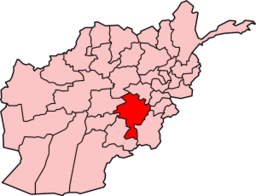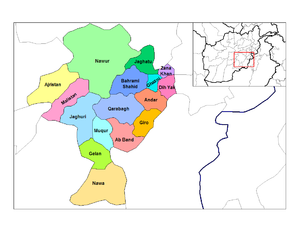Ghazni Province
| Ghazni (Ï║Ï▓┘å┘ë) | |
| Province | |
| Country | |
|---|---|
| Capital | Ghazni |
| - coordinates | |
| Area | 22,915 km┬▓ (8,848 sq mi) |
| Population | 931,000 (2002) |
| Timezone | UTC+4:30 |
| Main languages | Pashto Dari Persian |
 Map of Afghanistan with Ghazni highlighted
|
|
Ghazni (Pashto: Ï║Ï▓┘å┘è) (Persian: Ï║Ï▓┘å█î) is one of the thirty-four provinces of Afghanistan.Babur records in his Babur-Nama that Ghazni is also known as Zabulistan[1] It is in the east of the country. Its capital is Ghazni City. The province lies on the important Kabul to Kandahar road, and has historically functioned as an important trade center between those two major cities.
Contents |
History
Buddhism and Indian Influence
Ghazni was a thriving Buddhist center before and during the 7th century AD. Excavations have revealed religious artifacts of both Hindu and Buddhist traditions .
| ÔÇ£ | The two other great Buddhist centers , Fondukistan and Tepe-e-sardar (Ghazni) in its later phase are a very different matter and display another phase of influences coming from India from the seventh to eighth century . The representations show themes from Mahayana iconography and even in the case of the latter site assume Tantric aspects which had already established themselves in the large Indian monasteries like Nalanda.[2] | ÔÇØ |
| ÔÇ£ | Another important site is that of Tepe Sardar (better known as Tepe-yi Nagara .Tepe of the kettledrum )near Ghazni , which was occupied until perhaps the eighth century AD.From this period dates a huge statue of the Parinirvana Buddha (Buddha lying down at the end of his cycle of rebirths ) of unbaked clay . A very similar statue has been found just north of Afghanistan ,at the site of Adzhina tepe in Tajikistan , Yet what is most interesting , was the find at the same site of a statue of the Hindu deity Durga Mahishasura-mardini[3] | ÔÇØ |
In 644 AD, the Chinese pilgrim Hs├╝an-tsang visited Jaguda, Ghazni, while travelling from the country of Varnu, crossing the land of O-po-kien (Afghans i.e. Pashtuns).[4][5]
Advent of Islam
In 683 AD, Arab armies brought Islam to the area and attempted to conquer the capital of Ghazni but the local tribes fiercely resisted. Its resistance was so famed that Yaqub Saffari (840-879) from Zaranj made an example of Ghazni when he ranged the vast region conquering in the name of Islam. The city was completely destroyed by the Saffarids in 869.[6] A substantial portion of the local population including Hindus and Buddhists were converted to Islam by Mahmud of Ghazni
| ÔÇ£ | 'The region had previously been conquered by Mahumad of Ghazni and the population converted to Islam .[7] | ÔÇØ |

After the rebuilding of the city by YaqubÔÇÖs brother, it became the dazzling capital of the Ghaznavid Empire from 994 to 1160, encompassing much of northern India, Persia and Central Asia. Many iconoclastic campaigns were launched from Ghazni into India. The Ghaznavids took Islam to India and returned with fabulous riches taken from both prince and temple god. Contemporary visitors and residents at Ghazni write with wonder of the ornateness of the buildings, the great libraries, the sumptuousness of the court ceremonies and of the wealth of precious objects owned by GhazniÔÇÖs citizens.
Attack by Mahomed Ghori
Ferishta records attacks by Mahomed Ghori .
| ÔÇ£ | 'at the same time most of the infidels who inhabited the mountains between Ghazni and the Indus were also converted , some by force and others by persuasion [8] | ÔÇØ |
Its eponymous capital was razed in 1151 by the Ghorid Alauddin. It again flourished but only to be permanently devastated, this time in 1221 by Genghis Khan and his Mongol armies.
Ghazni is also famous for its minarets built on a stellar plan. They date from the middle of the twelfth century and are the surviving element of the mosque of Bahramshah. Their sides are decorated with geometric patterns. Upper sections of the minarets have been damaged or destroyed.
The most important mausoleum located in Ghazni is that of Sultan Mahmud's. Others include the tombs of poets and scientists, for example Al Biruni and Sanayee.
The only ruins in Old Ghazni retaining a semblance of architectural form are two towers, about 43 m (140 ft) high and some 365 m (1,200 ft) apart. According to inscriptions, the towers were constructed by Mahmud of Ghazni and his son.
In the 1960s a 15-meter female Buddha was discovered lying on its back and surrounded by empty pillars that once held rows of smaller male Buddhas. Parts of the female Buddha have been stolen. In the 1980s a mud brick shelter was created to protect the sculpture, but the wood supports were stolen for firewood and the shelter partially collapsed.
During the First Anglo-Afghan War, the Ghazni's capital city was stormed and taken over by the British forces on July 23, 1839 in the Battle of Ghazni. The Afghan Civil War and the continued conflict between the Taliban and the Afghan Northern Alliance during the 1990s put the relics of Ghazni in jeopardy. The Taliban placed Fazl Uddin in charge of protecting the artifacts.
GhazniÔÇÖs strategic position, both economically and militarily, assured its revival, albeit without its dazzling former grandeur. Through the centuries the city figures prominently as the all important key to the possession of Kabul.
Some Sikhs and Hindus also live in Ghazni province. During the Taliban regime they fled the country, but with the current administration they have returned to Ghazni city.
Since the U.S. invasion of Afghanistan in October 2001, there has been a Provincial reconstruction base and a Nato forces base. These western forces (mostly Polish Armed Forces) are hunting Taliban militants and al-Qaida, who are still active in the area causing deaths to Afghan government employees and local civilian population of the province as well.
Political and Security Situation

Like many southern Afghan provinces, Ghazni has a precarious security situation. The Taliban are reported to control most of the rural areas outside of the capital [4], and are heavily involved in attacks on provincial schools and government infrastructure. The province has avoided the outright warfare seen in other areas of Afghanistan such as Helmand Province and Kandahar Province, but that is due more to political expediency and the tactical plans of the NATO ISAF force than the existence of a stable security situation in the province. Ex-Governor Taj Mohammad was killed by terrorists in 2006 after being appointed police chief of the province with a mandate to quell the power of the Taliban. On the same day there was an unsuccessful attempt on the life of the governor at the time, Sher Alam Ibrahimi [5]. There is an Polish and American Provincial Reconstruction Team base located in Ghazni City.
In late April 2007, news agencies reported that Taliban fighters had taken control of Giro District in the province. The Taliban reportedly killed the district administrator, chief of police (who had been on the job for only one month) and three police officers. The Taliban withdrew from the district center one day later.
In July 2007, 23 South Korean volunteers were kidnapped in the Ghazni province by the Taliban. Two of them were killed and their bodies were dumped in various places. As of August 1, security force was planned to be deployed to secure the release of those kidnapped.
Natural Disasters
In recent years, Ghazni has been beset by droughts, heavy snow, and flooding, all at different times [9]. During the periods of drought, many parts of the province, especially Ghazni City, saw heavy building in the flood plains of the province's rivers. Flooding caused by heavy rain and snow in recent years have taken heavy tolls in property in lives in these newly constructed areas [10].
Natural Resources
Recent geologic surveys have indicated Ghazni may have one of the world's richest deposits of lithium. Together with other newly (2010) discovered mineral deposits, the total value of Afghanistan's mineral wealth may exceed $1Trillion US[11].
Government
Governors
The current Governor of the province is Osman Osmani.
Demographics and geography
The major ethnic groups in the province are Pashtuns (51%), and Persian speaking Hazaras and Tajiks (47%).[12] There are also some Burki, and Uzbeks. Ghazni is made up of 19 districts (district capitals are given in parentheses).

| District name | District Center | Ethnical data(%) [13] |
|---|---|---|
| Ab Band | Haji Khel | 100% Pashtun |
| Ajristan | Sangar | 97% Pashtun, 3% Hazara |
| Andar | Miray | 100% Pashtun |
| Dih Yak | Ramak | 89% Hazara, 11% Pashtun |
| Gelan | Janda | 100% Pashtun |
| Ghazni | Ghazni | 50% Tajik, 25% Hazara, 25% Pashtun |
| Giro | Pana | 100% Pashtun |
| Jaghatu | Gul bahawari | 73% Hazara, 27% Pashtun |
| Jaghori | Sange-e-Masha | 100% Hazara |
| Khugiani | Khugiani | 99.9% Pashtun, 0.1% Hazara, Tajik and Uzbek |
| Khwaja Umari | Kwaja Umari | 45% Hazara, 35% Tajik and 20% Pashtun |
| Malistan | Malistan | 100% Hazara |
| Muqur | Muqur | 80% Pashtun, 20% Hazara and Tajik |
| Nawa | Nawa | 100% Pashtun |
| Nawur | Du Abi | 100% Hazara |
| Qarabagh | Qarabagh | 50% Hazara, 50% Pashtun |
| Rashidan | Rashidan | 96% Pashtun, 4% Hazara |
| Waghaz | Waghaz | Mostly Pashtun |
| Zana Khan | Dado | 100% Pashtun |
Malistan, Jaghuri, Nawur, parts of Qarabagh, Dih Yak and Jaghatu are part of the Hazarajat.
See also
- Ghazni (city)
- Sangar (town)
References
- Ôåæ Babur-Nama Translated from the original Turki Text of Zahirud'd-din Muhammad BABUR padshah Ghazi by Annette Susannah Beveridge Vol1 and 11 Published by Munshiram Manoharlal Publishers ,Page 217
- Ôåæ Buddhism in Afghanistan and Central Asia By Simone Gaulier, Robert Jera-Bezard, Monique page 2
- Ôåæ The Afghans By Willem Vogelsang Edition: illustrated Published by Blackwell Publishing, 2002 Page 185
- Ôåæ BA Litvinsky, Zhang Guand-Da, R. Shabani Samghabadi, History of civilizations of Central Asia, pg. 385
- Ôåæ Hui-li, 1959, p. 188
- Ôåæ Nancy Hatch Dupree - Chapter 9 (Ghazni)... Link
- Ôåæ The wonder that was India II by S A Rizvi Published by Picador India Page 16
- Ôåæ Ferishta translated by John Briggs page 104
- Ôåæ [1]
- Ôåæ [2]
- Ôåæ [3]
- Ôåæ Ghazni provincial profile
- Ôåæ Ethnic demographic statistics taken from http://www.aims.org.af
External links
- FONDUKISTAN images from Kabul Museum
- Buddhism and Its Spread Along the Silk Road
- Afghanistan Gold Treasures ÔÇôNational Geographic
- Historical Sketch of Buddhism and Islam in Afghanistan
Archaeology
- The Buddhist Cave complex at Homay Qala , South Asian archaeology 1975: papers from the third International Conference ...Page 119 By Johanna Engelberta Lohuizen-De Leeuw
|
|||||||
|
|||||